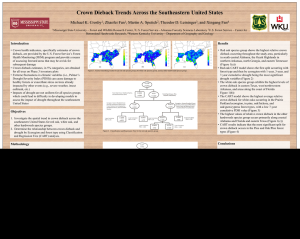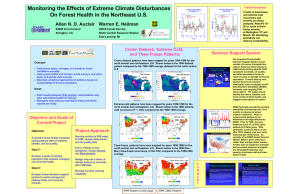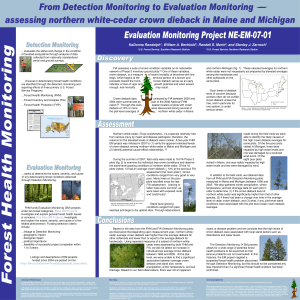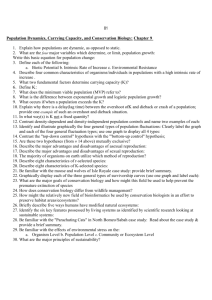Assessing Crown Dieback in the Ozark Highlands Using FIA and...
advertisement
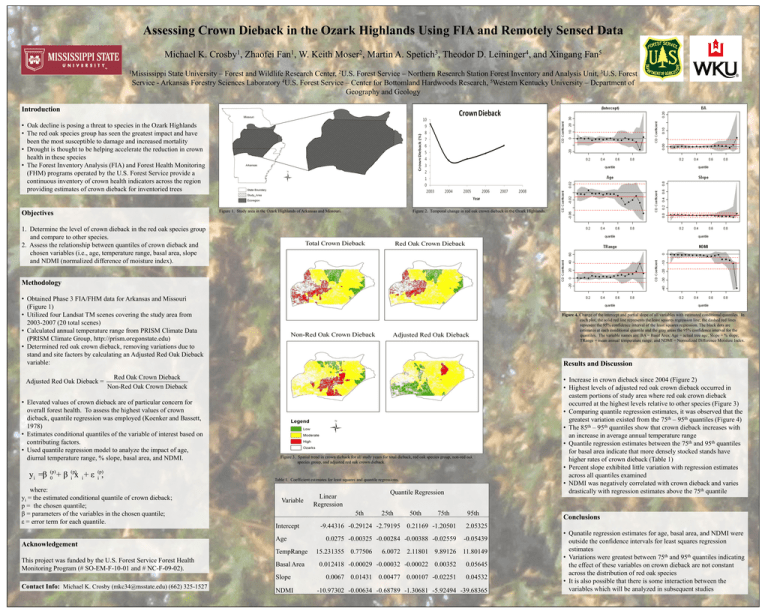
Assessing Crown Dieback in the Ozark Highlands Using FIA and Remotely Sensed Data Michael K. Crosby1, Zhaofei Fan1, W. Keith Moser2, Martin A. Spetich3, Theodor D. Leininger4, and Xingang Fan5 1Mississippi State University – Forest and Wildlife Research Center, 2U.S. Forest Service – Northern Research Station Forest Inventory and Analysis Unit, 3U.S. Forest Service - Arkansas Forestry Sciences Laboratory 4U.S. Forest Service – Center for Bottomland Hardwoods Research, 5Western Kentucky University – Department of Geography and Geology Introduction • Oak decline is posing a threat to species in the Ozark Highlands • The red oak species group has seen the greatest impact and have been the most susceptible to damage and increased mortality • Drought is thought to be helping accelerate the reduction in crown health in these species • The Forest Inventory Analysis (FIA) and Forest Health Monitoring (FHM) programs operated by the U.S. Forest Service provide a continuous inventory of crown health indicators across the region providing estimates of crown dieback for inventoried trees Figure 1. Study area in the Ozark Highlands of Arkansas and Missouri. Objectives Figure 2. Temporal change in red oak crown dieback in the Ozark Highlands. 1. Determine the level of crown dieback in the red oak species group and compare to other species. 2. Assess the relationship between quantiles of crown dieback and chosen variables (i.e., age, temperature range, basal area, slope and NDMI (normalized difference of moisture index). Methodology • Obtained Phase 3 FIA/FHM data for Arkansas and Missouri (Figure 1) • Utilized four Landsat TM scenes covering the study area from 2003-2007 (20 total scenes) • Calculated annual temperature range from PRISM Climate Data (PRISM Climate Group, http://prism.oregonstate.edu) • Determined red oak crown dieback, removing variations due to stand and site factors by calculating an Adjusted Red Oak Dieback variable: Figure 4. Change of the intercept and partial slope of all variables with estimated conditional quantiles. In each plot, the solid red line represents the least squares regression line; the dashed red lines represent the 95% confidence interval of the least squares regression. The black dots are estimates at each conditional quantile and the gray areas the 95% confidence interval for the quantiles. The variable names are: BA = Basal Area; Age = actual tree age; Slope = % slope; TRange = mean annual temperature range; and NDMI = Normalized Difference Moisture Index. Results and Discussion Red Oak Crown Dieback Adjusted Red Oak Dieback = Non-Red Oak Crown Dieback • Elevated values of crown dieback are of particular concern for overall forest health. To assess the highest values of crown dieback, quantile regression was employed (Koenker and Bassett, 1978) • Estimates conditional quantiles of the variable of interest based on contributing factors. • Used quantile regression model to analyze the impact of age, diurnal temperature range, % slope, basal area, and NDMI. yi =β (p) 0 + β x i+ ε , (p) i (p) i where: yi = the estimated conditional quantile of crown dieback; p = the chosen quantile; β = parameters of the variables in the chosen quantile; ε = error term for each quantile. Acknowledgement Figure 3. Spatial trend in crown dieback for all study years for total dieback, red oak species group, non-red oak species group, and adjusted red oak crown dieback. Table 1. Coefficient estimates for least squares and quantile regressions. Variable Intercept Age Basal Area Slope Contact Info: Michael K. Crosby (mkc34@msstate.edu) (662) 325-1527 Linear Regression 5th TempRange This project was funded by the U.S. Forest Service Forest Health Monitoring Program (# SO-EM-F-10-01 and # NC-F-09-02). Quantile Regression NDMI 25th -9.44316 -0.29124 -2.79195 50th 75th 0.21169 -1.20501 0.0275 -0.00325 -0.00284 -0.00388 -0.02559 15.231355 0.77506 6.0072 95th • Increase in crown dieback since 2004 (Figure 2) • Highest levels of adjusted red oak crown dieback occurred in eastern portions of study area where red oak crown dieback occurred at the highest levels relative to other species (Figure 3) • Comparing quantile regression estimates, it was observed that the greatest variation existed from the 75th – 95th quantiles (Figure 4) • The 85th – 95th quantiles show that crown dieback increases with an increase in average annual temperature range • Quantile regression estimates between the 75th and 95th quantiles for basal area indicate that more densely stocked stands have higher rates of crown dieback (Table 1) • Percent slope exhibited little variation with regression estimates across all quantiles examined • NDMI was negatively correlated with crown dieback and varies drastically with regression estimates above the 75th quantile Conclusions 2.05325 -0.05439 2.11801 9.89126 11.80149 0.012418 -0.00029 -0.00032 -0.00022 0.00352 0.05645 0.0067 0.01431 0.00477 0.00107 -0.02251 0.04532 -10.97302 -0.00634 -0.68789 -1.30681 -5.92494 -39.68365 • Qunatile regression estimates for age, basal area, and NDMI were outside the confidence intervals for least squares regression estimates • Variations were greatest between 75th and 95th quantiles indicating the effect of these variables on crown dieback are not constant across the distribution of red oak species • It is also possible that there is some interaction between the variables which will be analyzed in subsequent studies
